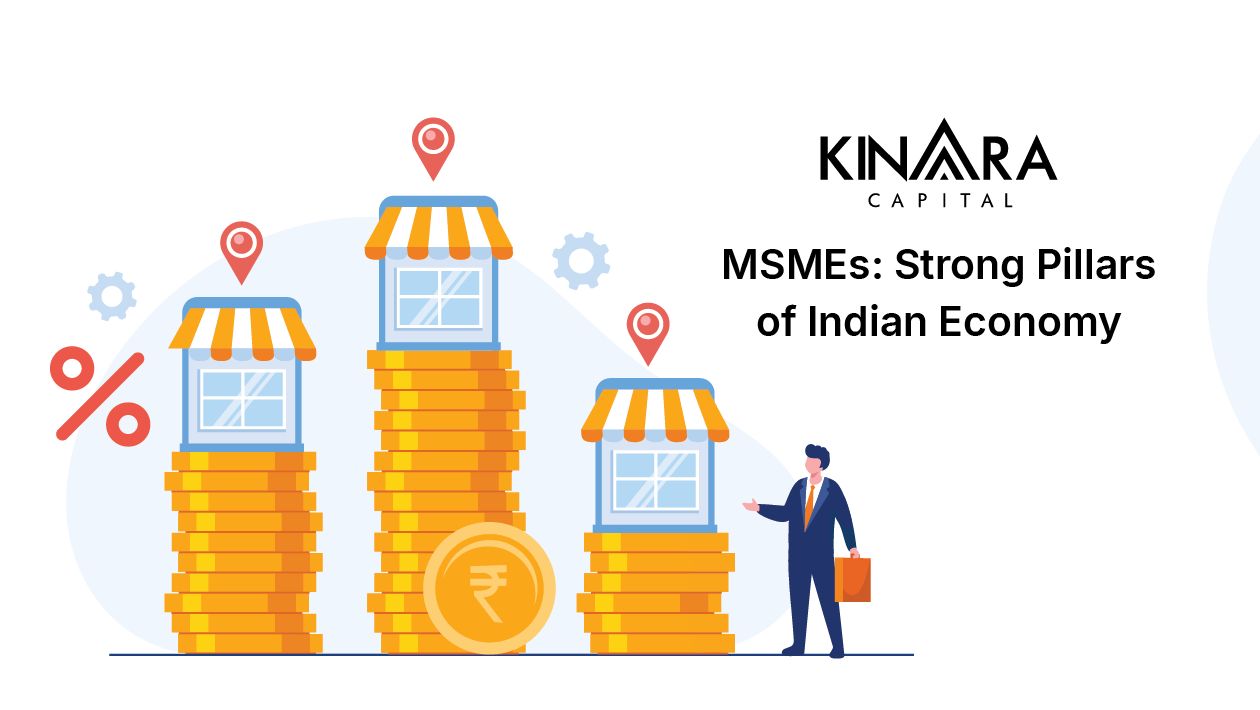
Micro, Small, and Medium Enterprises (MSMEs) in India play a pivotal role in the country’s economic growth. Known as the backbone of India’s economy, it creates multiple job opportunities and encourages innovations in businesses. Additionally, this industry not only has substantial contributions to the Gross Domestic Product (GDP) but also enables the industrialisation of rural and semi-urban regions, promoting balanced development across all cities. This relationship between MSME and Indian economy is essential, as their overall impact is crucial for the stability and expansion of the nation’s financial sector.
The MSME sector in India comprises Micro, Small, and Medium Enterprises that significantly contribute to the nation’s economy. Government policies like “Make in India” and “Startup India” have increased its growth, resulting in a fair amount of interest in entrepreneurship and industrial development in rural and semi-urban areas. The MSME sector is often categorised on the basis of investments and turnovers. Micro enterprises are small-scale businesses with investments up to ₹1 crore and turnovers up to ₹5 crore. Small enterprises with investments up to ₹10 crore serve as a bridge between smaller and larger sectors. Medium enterprises have investments up to ₹50 crore and make substantial contributions to technological and industrial development along with creating new job opportunities.
Celebrated on June 27th, World MSME Day represents the importance of Micro, Small, and Medium Enterprises (MSME) in the economy. In India, MSME is essential for economic growth, contributing significantly to employment opportunities and exports, which also impact the country’s GDP. A lot of small-scale businesses, such as manufacturing, services, agro-based industries, and handicrafts, are an integral part of MSME. In manufacturing, MSME produces a wide variety of products like textiles, machinery, and food items. In services, MSMEs include IT, retail, and hospitality businesses that help in bringing diversity and innovation to the market. Agro-based MSME processes add value to agricultural products, which allows farmers to earn more and promotes rural development. Handicrafts and cottage industries, often run by this sector, preserve traditional crafts and provide jobs, especially in rural areas. These enterprises also play a significant role in exports, accounting for about 45% of India’s total exports with products like garments, goods, and leather items.
World MSME Day is important because it brings attention to the challenges these businesses face, such as difficulty in getting business loans, accessing new technology, and reaching more significant markets. The day encourages governments and other stakeholders to create policies and programs that support the growth and development of MSME. By recognising and helping MSME, we can create more jobs, drive innovation, and ensure that economic growth benefits all parts of the country, making the economy more substantial and inclusive.
The MSME sector in India contributes to various economic parameters that help in India’s economic growth. It accounts for approximately 30% of India’s GDP, further highlighting its importance in today’s market. They are also major employment generators, providing jobs to over 111 million people, making them the second-largest employer after agriculture.
In terms of exports, MSMEs contribute about 45% of India’s total exports, exporting a diverse range of products such as textiles, garments, engineering goods, and handicrafts. They not only support economic growth but also lessen the gaps between developed and rural areas by creating a balanced regional development.
The importance of MSME sector in India lies in its ability to drive new inventions, promote a competitive environment, and adapt to changing market dynamics, making it a cornerstone of the country’s economic landscape.
Despite being a vital element of the economy, the MSME sector in India faces several significant challenges that hinder its development. One such challenge is finance access. Traditional banks tend to be very strict when it comes to giving out loans and require high collateral, which makes it hard for most MSME to get funds for expansion or to upgrade their technologies. Consequently, they are limited in terms of how big they can grow.
Another challenge for the sector is embracing new technologies. Several MSMEs rely on outdated technology, which leads to low efficiency and productivity levels. Among other obstacles, the absence of new technology and tools deters them from competition with other technologically advanced firms. The lack of technological adoption narrows down their scope and limits their market coverage.
Regulatory compliance also presents an alarming obstacle. For example, Indian MSMEs have to deal with complex legal formalities that entail various laws encompassing labour, environmental, and tax requirements, among others. As these regulations call for compliance, they drain valuable time and human resources that could otherwise have been spent running business activities, thereby hindering growth.
Non-banking financial Companies (NBFCs) play a vital role in addressing the difficulties faced by MSMEs in India. Regular banks usually have strict loan criteria that require high security, which many small businesses cannot afford. Nevertheless, NBFCs provide these enterprises with more flexible and convenient finance for MSME.
NBFC provides easy access to loans for MSMEs through digital platforms and collateral-free loans. One can even raise funds without the burden of traditional bank loans. This flexibility allows them to invest in technology, expand their business, and enhance competitiveness.
Furthermore, these NBFCs are powered by cutting-edge technologies that simplify loan application and approval procedures. They use digital means to assess MSME credit ratings much faster, thereby cutting down on the time and paperwork involved in securing finance. This type of digitisation speeds up lending processes while also making it possible for it to be available to small-scale businesses that lack extensive financial records.
By providing quicker and more available financial solutions, NBFC loans help MSMEs overcome the significant hurdle of securing finance. This support is crucial for the growth and sustainability of the MSME sector, enabling these enterprises to contribute more effectively to the economy.
The MSME sector in India is indispensable to the economy. It influences the GDP, employment, exports, and much more. Although there are some challenges in accessing finance, adopting new technologies, and navigating regulatory compliances, MSMEs in India continue to drive economic growth and innovation consistently. Financial solutions NBFCs help overcome these shortcomings and provide effective results. NBFCs offer several advantages over traditional banks, including unsecured, collateral-free business loans, which are beneficial for businesses lacking substantial collateral. The digital application process requires minimal documentation, allowing for quicker disbursement of funds, sometimes within 24 hours. It provides flexible loan amounts and repayment options tailored to the varied financial needs of MSMEs. NBFCs are important in overcoming the financial challenges faced by MSMEs, providing accessible and efficient financial solutions that drive economic growth, innovation, and development.
MSMEs (Micro, Small, and Medium Enterprises) are important for India’s economy, contributing about 30% to the GDP and 45% to exports. They also employ over 111 million people and drive innovation and balanced regional development.
SMEs (Small and Medium Enterprises) serve as India’s backbone by creating jobs, promoting innovation, and supporting large industries. They generate substantial employment, especially in rural areas, and contribute significantly to the manufacturing and services sectors.
Small-scale industries (SSIs) offer several key advantages. They generate numerous jobs, especially in rural areas, and can quickly adapt to market changes. They encourage entrepreneurship and innovation and supply essential materials and components to large industries, thus supporting the broader industrial ecosystem.
MSMEs in India are financed through various sources. Traditional banks offer loan schemes, but these often require substantial collateral and extensive documentation. In contrast, Non-Banking Financial Companies (NBFCs) provide flexible, collateral-free loans with a streamlined digital application process, enabling quick disbursement of funds, sometimes within 24 hours. It uses alternative data for credit assessment and has a strong presence in remote and underserved regions, making it highly accessible to small business owners. Government schemes, including the Credit Guarantee Fund Trust for Micro and Small Enterprises (CGTMSE) and Pradhan Mantri MUDRA Yojana (PMMY), also support MSMEs. Additionally, alternative financing options like peer-to-peer lending, crowdfunding, and venture capital play a significant role in funding these enterprises.
